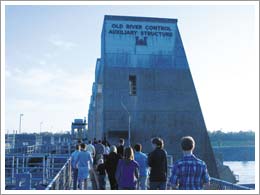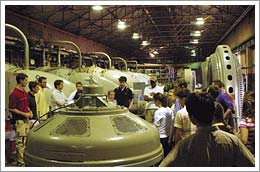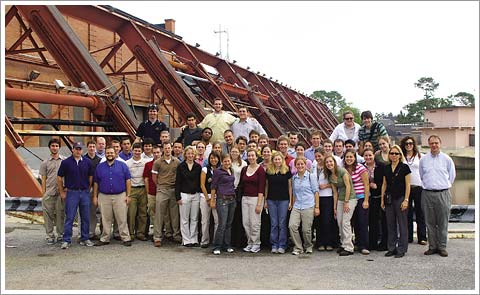Old Man River
Everyone in the country knows about Hurricane Katrina. They have
seen footage on the evening news of homes and lives devastated by
the storm.
They have heard about rebuilding efforts. What most Americans
may not realize is that “fixing the problem,” involves
more than time and money. Vital to the country’s economy and
culture, the Southern Louisiana and Mississippi region presents critical
challenges in a number of areas, including marshland ecology and
environmental engineering, structural and soil engineering, hydraulic
engineering, and plate tectonics.
Faculty wanted
to help students in CE30125: Computational Methods and CE30300:
Introduction to Environmental Engineering better understand these challenges by
having them learn about the area’s infrastructure, why the levee system
failed, and the technologies that can help build a better and safer flood protection
system. To accomplish this, they designed a tour of the area for students.
All but one of the students, a mechanical engineering major, were from the
Department of Civil Engineering and Geological Sciences. Also joining the group
were four members of the U.S. Army Corps of Engineers stationed in the area.
The
technology behind the rebuilding was one focus of the tour. As students visited
the New Orleans District and Engineer Research and Development Center, they
met with senior project managers, the district engineer, and the head of the
Hurricane Protection Office, who explained the reconstruction process. Corps
engineers also demonstrated physical models that are being used to better understand
levee behavior. They toured the 26th largest supercomputer in the world, which
is being used to analyze hurricane storm surge and hydrodynamic loads in the
area, and they were able to see pump stations and other facilities, such as
the Old River Control Structure that keeps the Mississippi River flowing by
New Orleans instead of changing course toward the Atchafalaya River.
|
 |
<< The Mississippi River changed its course
about 750 years ago and began flowing to the area that is now New Orleans.
Over the last 100 years the river has been trying to adjust its course
once again. In the 1950s acting the under Congressional order, the
U.S. Army Corps of Engineers built the Old River Control Structure
to help maintain the course of the river around the city. |
 |
<< One of the 20 levee breaches in New
Orleans during Hurricane Katrina occurred at the 17th Street Canal
levee. During their field trip, Notre Dame students and faculty were
able to tour the pump house. |
Another focus was the link between natural
geologic processes and the engineered environment, specifically balancing
the needs of the environment with the safety of area residents and
the economic importance (locally and nationally) of waterways and ocean
and inland navigation.
During the trip students were able to experience the food and culture
that is uniquely New Orleans. More important, they saw a personal side
to engineering, the humanity motivating the technology. In an article
for Notre Dame’s Observer, the
student newspaper, junior Dustin Mennella wrote: “An
area called the Ninth Ward was in close proximity to one of the levee
breaches and, as one would imagine, was hit hard. Here, the water did
not just flood the area — a
tidal wave of escaping water crushed everything in its path. ... Even
the trees had died, due to the salt content of the floodwater. Telephone
poles laid on the ground, and more than once all that was left of a
house were the front steps, because the entire house had simply been
swept away. Incredible as the destruction was, hope remains, and the
people of New Orleans are slowly but surely returning and rebuilding.”
For detailed information about the trip, visit http://www.nd.edu/~jjwteach/30125/fieldtrip.html.

A total of 49 undergraduates, two graduate students,
four members of the Notre Dame faculty and staff, and four members
of the U.S. Army Corps of Engineers toured the Southern Louisiana
and Mississippi region in November 2006. The trip was sponsored
in part by the Murphy Travel Fund, provided to the Department
of Civil Engineering and Geological Sciences by Dennis F. Murphy
(B.S., CEGEOS ’71).
|
|




